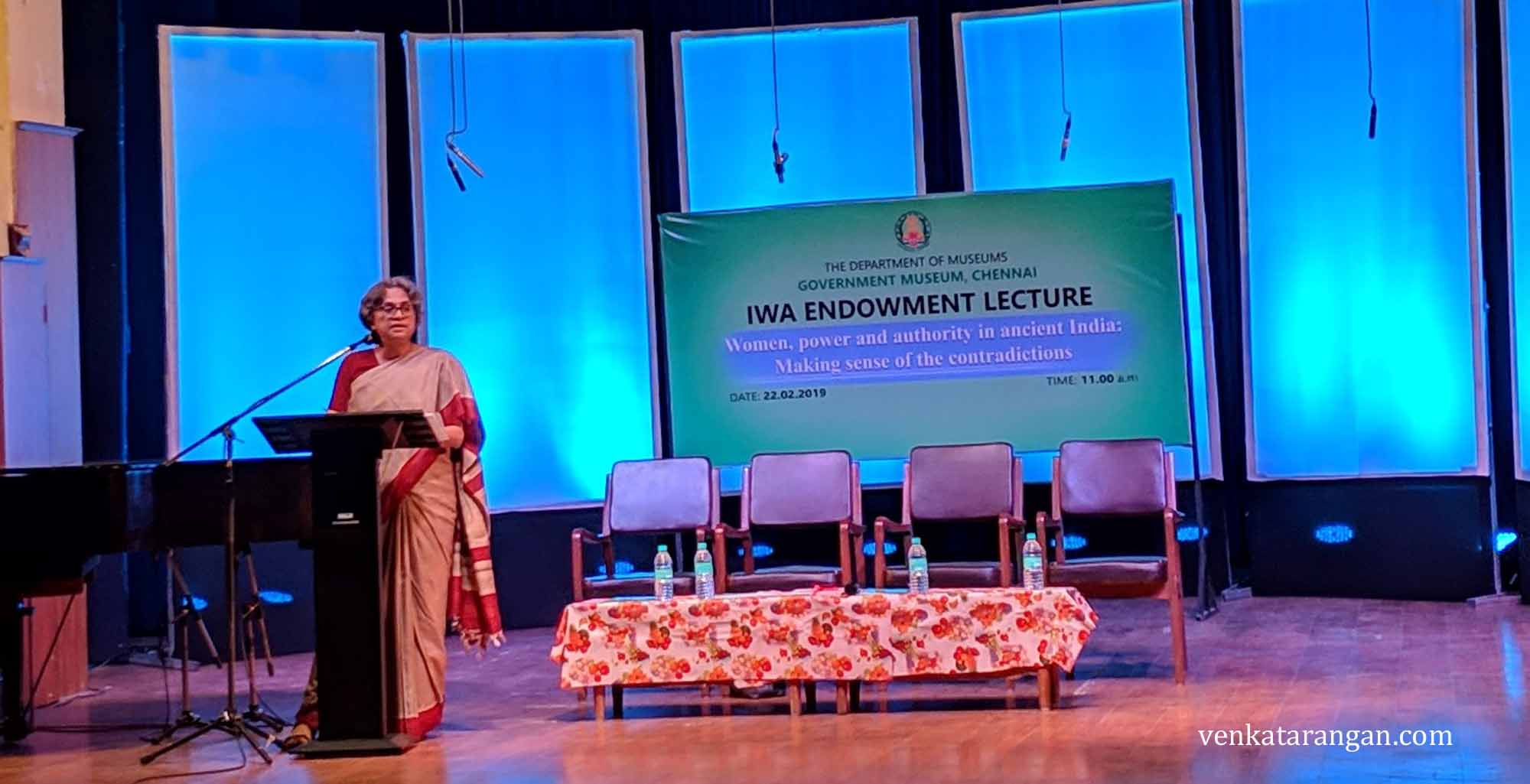Dr Upinder Singh, Professor of History, Ashoka University, Sonepat is known for her scholarly works on Ancient India, including her recent book “Political Violence in Ancient India” (video) in which she talks of the myth of a nonviolent India created in the last century. She is the daughter of former Prime Minister Dr Manmohan Singh, a fact she hardly publicises about.
Today, there was a talk of her organised at the Museum Theatre, Egmore by Department of Museums, Govt of Tamil Nadu. Titled “Women, Power and Authority in Ancient India“, the endowment lecture under the banner of International Women’s Association was fascinating.
As ordinary Indian’s, the knowledge we have of our own history is patchy – often it is polarised depending on our background and the ideologies we subscribe to – it becomes starker when it comes to our beliefs on how women were treated during the ancient times. Either we believe women were loved, cared for and revered, which got changed for the worst after the arrival of the colonial rulers from Europe; or reading from the historical works written by westerners, we believe that the women were actually saved from exploitation in the form of polygamy and from barbaric acts like Sati, thanks to the reforms enacted by the colonial masters. Quoting works from across the religions of Ancient India, Dr Upinder Singh eloquently explained that the truth was actually nuanced and lies in between.
The golden age for women lies not in our past, but certainly in the future – Dr Upinder Singh

Dr Upinder Singh delivering an endowment lecture in Museum Theatre, Egmore on “Women, Power and Authority in Ancient India“
- Manu Smriti, dated 2nd BC to 3rd CE (Wikipedia), is the often quoted work when it comes to this topic (and the caste system in India) by all parties. When it comes to how women were to be treated, this work has contradicting materials. At places, it talks of women to be regarded as the Mother of creations and to be revered above the Gods, in some other places it is plain nasty about women and below everyone else in the hierarchy – yes, diagonally opposite positions in the same text.
- When reading these texts, we should remember that the texts we have with us were written by the upper-class men, for consumption by the mostly upper-class brahmin men. So the bias and prejudices are to be expected and accounted for.
- In Hindu texts, the role of a woman was to accompany his husband (thereby giving him the eligibility of being a person qualified to) during the performance of yajnas and pujas, but the woman by themselves could not do the yagnas.
- Rigveda believed to be from 1500-1200 BC (Wikipedia), talks of an egalitarian society, but it was certainly an equal society – no society could’ve been egalitarian where slavery was enshrined. However, the caste system which is familiar to us now were not seen in this period (yet). We do see references to female slaves (dasi), they were exploited sexually and placed at the bottom of society. Goddesses were not as highly respected as those of the Gods.
- From many texts, we understand the importance placed on the household patriarch, who holds absolute control over the productive assets of the family and over the reproductive assets of his wives. This control over the women sexuality is important for maintaining the caste system which can be achieved only through the purity of the lineage. We see various reasons, under which a husband can rightfully abandon his wedded wive(s) like when the wive is addicted to alcohol, barren, or harsh-spoken (this was regarded to the worst and can be a reason for immediate action)
- Buddist texts had limited roles written for women. The bhikkhunīs (female monks or nuns) were placed below the monks, they had to be always present under the watchful eyes of the monks, they were considered to be temptresses – the texts adviced young monks to stay away bhikkhunīs at all cost, not to interact with them. We see little to no inscriptions written by the female monks.
- Contrast to the above, in South India, the Tamil Sangam poems, spanning from 300 BC to 300 AD (Wikipedia), has some of the most beautiful, eloquent love poems of/by/for the woman. We see young female protagonists on a regular basis. Women are seen employed, working in agriculture, raising animals, growing crops, as poets, making and selling toddy (country liquor), making and selling garlands/fish/pottery, performing as dancers and even trusted by the rulers for their security by employing female bodyguards. In general, they had great social and economic roles.
- In Buddist texts, we regularly see women as donors, even in Sanchi there are many inscriptions of such donations. Tripiṭaka (and Theravada ?) had woman poets.
- When it comes to politics, we see women having played roles either from the front or in the backdoor negotiations and power politics: Prabhavatigupta (385-405 AD) was the queen and regent of the Vakataka dynasty (Western Deccan), Kalahandi (near Odisha & AP) poets write about the three famous female rulers of the region; Rani Rudrama Devi (~1295 AD) was a monarch of the Kakatiya dynasty in the Deccan Plateau.



Comments